The search for the perfect waterborne cabinet paint is over!
In the search for a better cabinet grade waterborne finish, my company, JHC, recently started using SW Kem Aqua Plus. Its rare that I get excited about a new coating like this, but I am very pleased with the results we have been getting with this paint. Kem Aqua Plus is a waterborne pigmented lacquer finish system designed to be used for interior furniture, cabinetry and architectural mill work. It forms a very hard durable finish suitable for frequent traffic use on woodwork where a high performance coating is required and traditionally a solvent borne coating is used.
Being able to use a waterborne finish is much safer from not only a environmental standpoint, but it also negates explosion hazards as well. This is especially a concern when site finishing where certain things are out of the contractors control, or the home is occupied.
Directly from the Sherwin Williams PDS that can be found here:
• Meets Kitchen Cabinet Manufacturers Association (KCMA) over Sher-Wood® Kem Aqua® Plus Surfacer.
• Excellent mar resistance.
• Better resistance to microfoaming than other latex coatings.
• Excellent hardness, block resistance and print resistance.
• Good flow and leveling.
• Good flexibility – passes 20 KCMA Cold Check cycles.
• Very good resistance to yellowing.
• Very low VOC* – < 2 lb/gal.
Kem Aqua Plus is not for the novice
Our experiences with Kem Aqua Plus started three months ago when our Sherwin Williams rep suggested it for our cabinetry painting. This coating has a learning curve that I would consider fairly high. It is a very thin coating in comparison to the heavy bodied acrylics many contractors are accustomed to. Sags and runs can occur, and application techniques may need to be adjusted to achieve the desired finish. This is a spray only coating so touch ups must be sprayed as well. Its quick cure to sand time however makes repairs easy. Air movement will dramatically improve dry time, and you can sand any mistakes or blemishes and recoat in about an hour when direct air flow from a fan is applied. Another advantage of the quick cure time is odor control. You can feel comfortable spraying this coating in an occupied home where air quality must always be a concern. The smell dissipates very quickly, leaving only faint paint odors remaining.
Micro-foaming
Pigmented wb lacquers have traditionally had a major drawback- micro foaming. It is best described as tiny bubbles that can become trapped in the film if it begins to cure before they dissipate. Without the use of an approved retarded this is assured to happen, and require sanding and re coating. SW recommends Butyl Cellosolve R6 K25 for a retarder at a ratio of no more than 5%. Micro foaming occurs very easily with vigorous agitation and high pressures found in airless or air assisted spray systems. While Kem Aqua Plus is resistant to micro foaming, it is not immune to this negative characteristic. Most all micro foaming can be avoided by using hvlp systems for application, and proper reduction.
Primed for Success
Kem Aqua Plus Surfacer will be my next article so stay tuned. We really love this primer, and I think contractors especially those in new construction will appreciate the performance and capabilities of this coating for interior millwork.
Our results using this system for cabinet grade finishes has been phenomenal as you can see below.

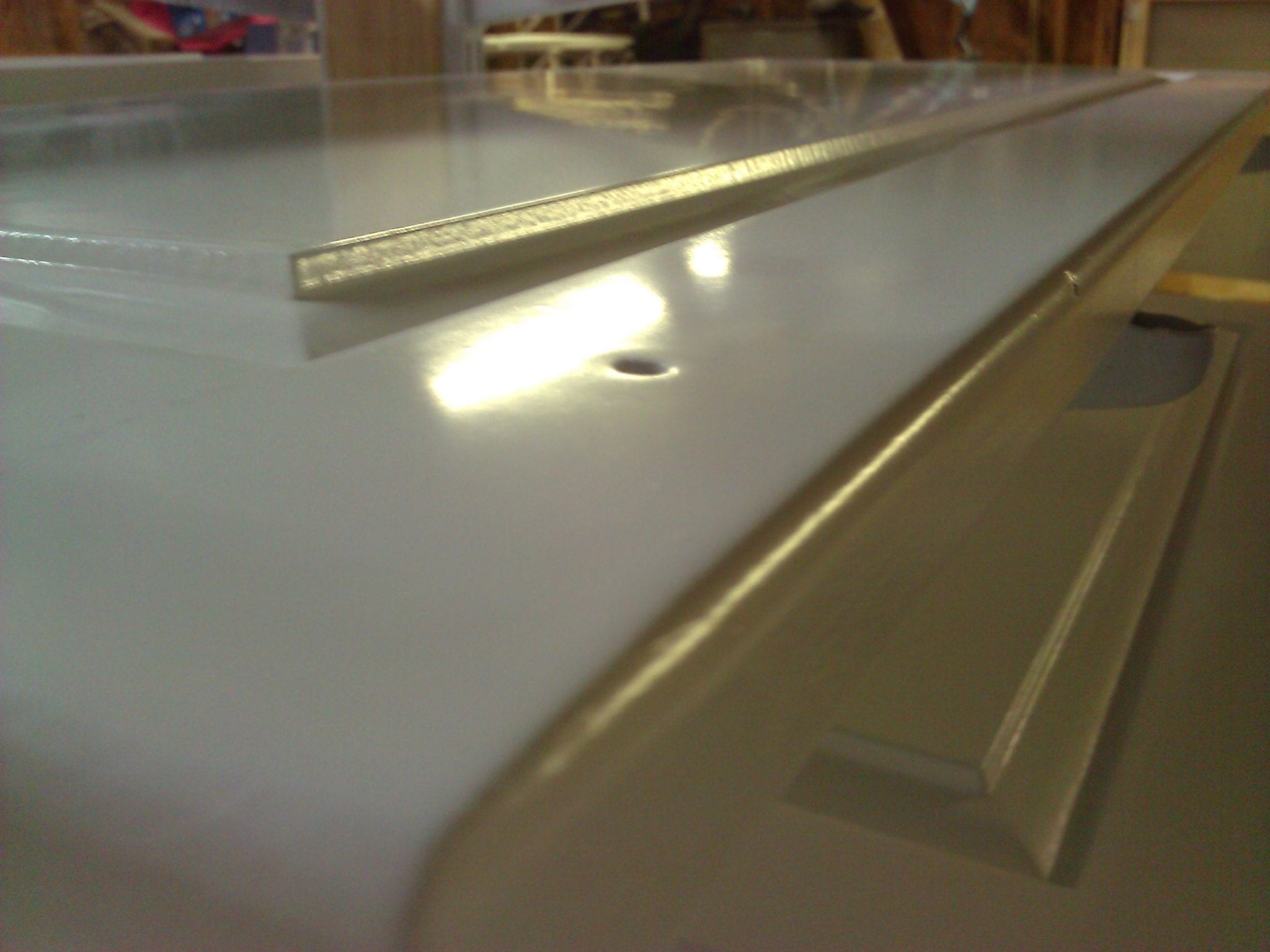
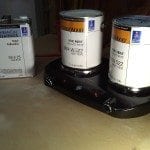
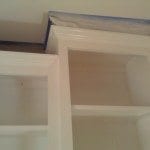

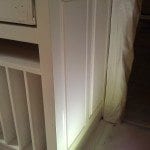
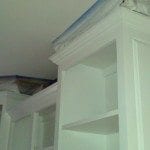
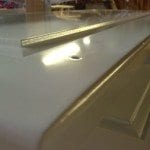
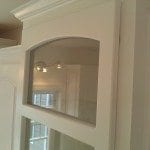
Sherwin Williams is good company
Yes they are a good company with many good products along with outstanding service capabilities.
Just tried this one out last week. You’re definitely not joking about how thin it comes out, but I don’t think it was all too hard to apply.
I too love the Kem Aqua Product and have been using it with great success in my small furniture refinishing business (do mainly color). My question to you is, do you clear coat over top of the pigmented KA? I have gone back and forth with the SW reps I deal with and they say no, so I do not, unless I am glazing, then I do a clearcoat. Just wondering what your opinion and thoughts were on this subject.
Thanks in advance for any info you can provide!
Julie
What are you using for a clear over pigmented kem aqua?
If you are using clear kem aqua do you have problems with discoloration?
Where I wor clear coat over the pigment coat.
1. Calling this waterborne a lacquer is misleading. It’s a waterborne emulsion. It shares nothing at all in common with lacquer.
2. It does not lay out well. Compared to any solvent system this stuff does not spray well.
I work in a factory. We have ten spraybooths in constant running. Each spray operator has more than a dozen years of spraying experience.
3. Touching up waterborne finishes is not a fun job. I cannot stand waterborne. The whole push to green is a pathetic waste and a sad pusuit. No waterborne replaces the ease and durability of solvent systems.
I agree with you completely. It take many years for the solvent systems to yellow. My take on the painting industry at current is discouraging if a surface will hold paint long enough for the check to make it to the bank before failure then is sorry about your luck Chuck. You have to be careful though you don’t say to much you can be sued for slander or defamation.
I being using this product for over two years.
I use topcoat only when I glaze kitchens cabinets and doors but I use the low gloss.
Regular paint job I use mid gloss.
Yes you do need to add Clear coat on it… if you using water-based Lacquer make sure you spray them with Sherwilliam water-based clearcoat if its precat and post cat Lacquer them you can spray them with Any clearcoat that are approved for Postcat and precat Lacquers
Juile,
We haven’t done anything with KA plus clear coats yet. I don’t really see the need for doing one over color coats, and like you would only use it over glaze or possibly a burn through color.
I use Sherwin Williams for nearly everything, great brand!
Thank you very much for this information. Does anyone know how well the Surfacer works on MDF ?
I don’t recommend use directly, i think you should use a good sealer before you paint.
I would use something like Zinsser (Shellac) Primer over bare MDF. Sand, then apply Kem Aqua Surfacer, sand, then apply two coats of Kem Aqua White finish sanding between each coat. To be perfect then spray a coat of Kem Aqua Clear coat. CAUTION: DONOT use water based primers on MDF as MDF will absorb the water and swell ruining your MDF surface.
Justin it works extremely well. Follow sanding procedures before you apply.
Thank you Tommy. Great website.
Not really a comment a question can the waterborne lacquer be used over an oil like tung oil or linseed oil
Robert, I don’t see why it couldn’t. Finding the right tie coat like seal coat and primer would be the key, I have used this product under white shellac many times now and it worked great. I would get up with SW tech and ask what they approve.
When I spoke with my local sw person they said they couldn’t find the kem aqua surfacer in the system.. Are you still able to get it? If not, are you using a different surfacer/primer under the kem aqua plus?
Tammi,
Here is a link to the product page for the surfacer. .
http://oem.sherwin-williams.com/ca/eng/oem/products/sherwood_kem_aqua_plus_surfacer/?referringCategory=categories/wood/primers_sealers_surfacers/
Tommy,
Do you use the BC K25 and or water with the KA plus? I’ve been adding both with mixed results. Right now I have pin holes on second coat over a first coat that looked great. I’m using AAA 411 flat tip 600 lbs fluid and 18 lbs of air. I do have shop air HVLP as well.
Bill,
Sorry it took so long to reply. I use both the retarder and water to thin and get the results I need. Many times when applying a second coat this paint acts completely different, and micro foaming rears its head.
I have found using an hvlp turbine or traditional air is the best way to apply. Even 600 psi fluid is too much for this coating. We always use the hvlp turbine now to apply, it rules out so much of the issues like the pin holes you are seeing.
Hope this helps.
Tommy, thanks. Do you keep the water/ retarder at about 5% total? Love the product just want to dial it in as best I can. I will try the turbine as well. Thanks again.
What is the make/model of the paint warmer you are using? Thanks!
This really looks like a copy and paste from the Kem Aqua technical documentation…. I would have liked a little more personal insight… I’m thinking especially of the microfoaming paragraph that you copied from the TDS (and didn’t credit the TDS for). The Butyl Cellosolve is not even for sale anywhere. A useful article would have posted exact settings for your spray system.
Can’t you get butyl cellosolve from your local SW Industrial Finishing distributor? I did.
This stuff sprays best with conventional air, not AAA, sadly. SW suggests to turn down the air in the spray booth, limiting air flow. They suggest to air dry rather than heat lamps.
If you can tolerate some orange peel, then ok. I prefer glass smooth and for where I’m working this fine standard seems impossible with waterbornes.
We built a theater bar and wet bar with hickory wood and need to finish it. We want to use Watco Danish Oil in a dark brown and top coat 3 or more coats with the Kem Qua Plus clear. Can this be done? Water base over the oil. Thanks Char
Char,
I am almost certain that the TDS states you can use it under Sherwood wiping stain which is oil based. If it were me I would put in a call to SW tech support. If you have scraps I would test it on them as well before proceeding.
They will probably tell you the system has only been tested with SW stain.
Thanks, What is the TDS? We used Watco Danish Oil and want to finish it with the Kem Aqua Plus clear water base. Char
In your case there is no reason to use Watco. You can achieve the same look (that of depth, chatoyancy) TDS: technical data sheet
If your undercoat is 100% cured then lay down a spitcoat (a very thin coat) of shellac. Zinsser’s Sealcoat is fine for that. Scuff smooth. Then dust on your first coat or two of your waterbase, after which you can do full wetcoats.
It’s unlikely that SW tech support will advise or give sanction to your finish. They are there to tell you how to use their product as it is designed and formulated to be used, and not as something incorporated into maverick finishing systems. All tech support teams are like that.
You are on your own because of your finish fails for any reason you cannot point a finger to them.
Just because something works doesn’t mean it will be sanctioned by the manufacturer.
There is no real reason that you must use Watco of your intention is to develop depth and chatoyancy of the wood and make the grain jump out at you. You can achieve that same look by using the SW clear alkyd stain base, cured, followed by their waterbase. And I think this is a sanctioned system.
I am planning on painting kitchen cabinets, they are oak and gave been finished with solvent based poly several years ago. Do I need to apply a primer or adhesive primer first and if so which one? Final coat of Sherwin Williams Aqua Coat applied with a HVLP? How many coats? Comments appreciated!
Yes. I usually prime with white shellac. Hvlp spray two top coats.
Where do you get those GE paint can warmers?
Great article, thanks for the tip. I’m an amateur woodworker/finisher that’s been looking for a good cabinet-grade WB paint for a while. Been playing with SW WB ProClassic thinned with Floetrol and water 12:2:3 paint:water:floetrol but it doesn’t seem to get that hard even after long cute times and poly topcoats. I’m going to call the commercial SW store next week to see if I can get some Kem Aqua to play with.
Did you ever publish the article on the Kem Aqua Plus Surfacer?
Max when you Spray Kem Aqua and or plus you will never consider spraying Pro classic
Kem Aqua dries hard and recoat in 30 mins. It sprays perfect from the can and levels great
It dries hard? Ha! Not in my experience. It levels great? No it doesn’t. I used it with a large team of other sprayers in a furniture factory with several spray booths all going at once.. This stuff is soft. It scratches if you look at it wrong. It levels to the surface of an orange and no smoother.
All the equipment used was suggested by Sherwin-Williams, their commercial division. Even their best tech guys couldn’t spray this stuff without orangepeel.
The bottom lone is till as it always was, waterbase is no substitute for a decent furniture grade solvent coating. Regular lacquer is a much better choice unless you are not set up to deal with solvents.
Hello sounds like a frustrating experience and my setup is no where near yours.
I understand solvent based is better than the WB but unfortunately it’s the future
I only spray WB finishes and not setup to deal with solvents.
From my experience with Kem Aqua I didn’t have those issues. I usually spray 40 kitchen doors at time with a 30 min recoat.
My setup using a Accuspray 10 gun (1.1mm needle and #7 air cap) and a pressure pot, fluid pressure 11# and 4 stage turbine (Fuji) at reduced pressure.
The Kem Agua was preheated to 90 degs using a can warmer and or hot plate
It sprayed on with a slight orange peel but levelled out perfect.
The surface is hard and within a few days passes the nail test
Thanks
Right there with you, Bruce. As a hobbyist in my garage, solvent-based just isn’t an option.
Besides the super-fast drying and recoat time, my primary interest in the Kem Aqua Plus is hardness. If this stuff is KCMA certified, surely it’s pretty good? I plan on using the KA+ Surfacer, then the KA+ White (tinted), and then the KA+ Clear as a topcoat. Any feedback on hardness/durability when using this system, and how many coats of each I should plan on doing for the best results? Based on the instructions it seems that one coat of Surfacer, two of White, and one of Clear should be plenty if left to cure properly, but since you obviously spray a lot of the stuff I’d love to hear any feedback you have. How long do you allow each coat to cure before hitting it with the next one? Also, do you find that heating the paint is a necessity for good results? I live in Florida so perhaps I’ll get a natural advantage as the weather is turning warmer and more humid.
Speaking about water-based finishes in general: as I said, I’m an amateur so perhaps my expectations are set a bit lower. But I am also something of a perfectionist in general, and I think I’ve had pretty decent results with water-based finishes. I looked at most of the painted surfaces in my house for comparison (cabinet doors, trim, walls, etc.) and if you look at all of them at just the right angle, there is some kind of texture/brushlines/etc. there even with solvent-based finishes such as the finish used on our trim. We had professional painters do some of the work I’m referring to. I’ve also looked at a lot of painted furniture that we own that has almost certainly been sprayed by robots in a factory and the quality of the surfaces, while generally the best of all of those I looked at, still has some kind of texture on it when looked at just right. I noticed these issues on surfaces I’ve lived with in my house for two years now, and thought were completely flawless until I gave them this close of an inspection and really tried to find their flaws. I have no doubt that a mirror-smooth gloss lacquered finish requires a zero-tolerance approach to orange peel etc. but for most painted surfaces in satin and flat, surely the same rules don’t apply in terms of practical aesthetics?
If I look at the SW ProClassic I sprayed after I’ve hit it with three coats of General Finishes High Performance topcoat, it looks as good as or better than pretty much any other painted surface in our house. I brought some samples of my work in for a friend who’s also a woodworker to get his honest feedback, and he agreed that the results are very good. If you look at the piece in just the right light from just the right angle, you can see a very slight wave/orange peel, but I’ve put the face frame I’m working on in its final destination, and I’d have to be on my hands and knees on the floor leaning my head just right to even notice this once the frame is installed. So while it isn’t perfect, it’s definitely within the realm of being so good that I’d never notice the imperfections.
As for hardness, once the GF HP poly is on and has had a chance to dry, I can go to town on it with my nail and it’s very difficult to make an impression. The closest I got was to very slightly degloss the bit I was scratching, while scratching it hard and fast with the corner of my thumbnail, and this was before the poly had fully cured. I checked the same piece a few weeks later and could just barely see a faint trace of the deglossing if I held the piece in the right light, so I think the deglossing had more to do with the piece not having cured fully than anything else.
Hello Max for me I’m just comfortable with the Kem Aqua, it works for me and in my area in Southern Ontario it’s priced at $49 a gal. I usually get only gals as my clients pick there own million shades of white lol. I usually can get around 55 doors, 2 coats per side/gal
I usually get those honey coloured older style oak doors, Tannin bleed through used to be an issue with regular primers
Now it’s just easier for me to pre clean with Tsp and just use Zinsser Bin shellac-base primer in a rattle can with spray handle. It sands great with 320 grit and preps for the Kem Aqua
I’ve tried ML Campbell Aqualente stain blocking primer and it works good but still a small amount of bleed through. Still looking for the magic bullet WB primer
Thanks
Thanks Bruce. So if I followed you, you’re using a coat of Zin shellac primer, two coats of KA+, and no topcoat. And based on that it sounds like you haven’t had any durability issues with the finish just using the KA+ without a topcoat, is that correct?
When there is a staining issue as for example the doors below the sink I use General finishes Enduro clear poly
Generally no issues, just prefer no call backs 😊
Thanks, good to know.
I just picked up the KA+ from the local SW Commercial shop. They were so much more knowledgable about spraying than the SW home store I’ve been going to so far, I wish I’d gone there first. I got a gallon of the Surfacer and the butyl cellusolve for cleanup, the Surfacer was just over $50/gal US for anybody who’s curious. This is about what I was paying for the waterbourne ProClassic with a 30% discount coupon.
I’ll let you know how it goes.
Bruce,
Boy this stuff rally is thin. Probably the thinnest substance I’ve viscosity tested beside water! It’s slightly thinner than GF HP Flat straight out of the can.
Question on the Butyl if you don’t mind: do you use it to clean your spray gun as recommended? I have a plastic Wagner gun which I usually just wash out with water. The Surfacer I viscosity tested cleaned right up with water no problem. The butyl seems like pretty nasty stuff based on the MSDS so I’d rather not use it unless 100% necessary.
Thanks again for all your advise.
Hello Max i just use soap and water, the Accuspray gun has to be the easiest gun to clean
I really just spray Kem Aqua not the plus. I will try it soon but for now maybe try a 1.1mm needle nozzle set. When I’m not using a pressure pot setup I use a 3m PPS setup. I’m sure you will like the 30 min recoat and professional finish
Kem Aqua is slightly thicker but overall nice to spray from the can without thinning
Keep us posted!
Bruce,
I sprayed some of the KA+ Surfacer on Saturday. I used a fine-finish HVLP gun to start with (1.6mm nozzle) since I was concerned about atomization on the nozzle on the regular gun (2.0mm). The finish went on with a very light spray and went on too dry, so it was a tad rough. I scuff sanded it out with 220-grit and it went lovely and smooth – this stuff really sands well, like confectioner’s sugar.
The next coat I put on with the regular gun with the 2.0mm nozzle at high pressure with low volume, and it shot really well and laid out lovely and smooth. As I mentioned before all the water based finishes I’ve shot so far seem to get the faintest of ripples but there was none of that with the Surfacer. All I got was a smooth, even coat. I’m going to sand this coat before I put the first coat of KA+ tinted white on top, but it’s so smooth already it almost doesn’t need sanding.
I can’t believe I’ve been screwing around with thinned latex for so long when this stuff has been out there the whole time. SW really needs to educate their consumer stores about this option. I’m probably going to email them when I’m done to suggest the same.
I ended up cleaning up with nothing but water – since it is thinner than latex, the KA+ cleans up easier than latex too.
I had to order the clear coat in the flat gloss level I wanted, which they’re expecting to come in this week. I should get the remaining coats of paint and clear laid down next weekend so I’ll post my results once the full system has been used.
You HAVE to scuff or sand between applications. You have no choice. You need a mechanical bond do that you have intercoat adhesion. Waterbase builds in layers. One layer does not bite or melt into the previous layer.
Thanks Bruce. Seems to be priced about the same as the ProClassic too (~$80/gallon bought in 1-gal increments). I was considering starting with a gallon of the surfacer to see how it sprays, and then use my experience with the surfacer to decide whether or not to go with the Plus White tinted to the color we’re looking for.
Hello Max glad it all worked out for you. I would try a smaller needle/nozzle set 1.3 mm, 2.0 mm is really too big.
For sanding I use the Mirka Molded Palm Sanding Block and Mirka Abranet 5″ H&L Mesh Discs (240) Nice thing the disks last forever and come in 80-1000 grit
Bruce
Bruce,
Well, I’ve successfully sprayed the KA+ on my test face frame. Two coats of Surfacer, two of tinted White, one of Clear in medium gloss since they only sell the flat gloss in 5-gal drums.
Wow, is this stuff great. Laid down flatter than any of the latex concoctions I’ve been fighting with for four months of weekends. The stuff dries in 30 mins to an hour even in my hot, humid summer FL garage. Sands like confectioner’s sugar. And two days after the Clear went on I went to town on it with my thumbnail and couldn’t make a mark. I’m finally ready to finish my real project.
Here’s a shot of the test frame after the second coat of tinted White went on before sanding.
https://www.dropbox.com/s/odlsu5p3njsngoh/kemaquaplus_2csurfacer_2ctintedwhite_noclear.jpeg?dl=0
I’d love to try a smaller tip but the cheapo Wagner gun I am using only has one nozzle size. They sell a fine-finish gun with a 1.6mm or so nozzle but I find it clogs up. Should’ve gone with the $399 Earlex HVLP instead; oh well. The results I’m getting with the KA+ are beyond good enough for my current project. If I decide to do some more cabinetry when we redo our bathrooms and go with a painted finish, I’ll treat myself to a better gun.
Thanks so much for all the advice and encouragement! I also picked up some Abranst pads from Amazon to give them a try this weekend.
– max
Max and Bruce, great discussion and teamwork. I’ll ping Tommy to see if he has anything to add. Max, if you want some more info on sprayers, head over to Topcoat Review, Scott has a few articles there, http://topcoatreview.com/category/product-reviews/sprayers/
Not sure I have anything to add. We have been spraying HVLP with 2.0, it works best for us, glad to see others are liking this coating as much as we do.
We concentrate on keeping good clients and with our maintenance programs we are back to do exterior house washing each year. This coating is holding up better than the finishes the cabinetry comes with. Clients are super happy and recommend us to all their friends and family.
Tommy and Bruce,
Question for you: I’m finding I get a few bumps in the finish when putting on a second coat of the KA+ tinted white. Best way to describe them is like little pimples. The rest of the finish is beautiful and flat. What I’ve been doing is smoothing out the pimples with 600-grit, and then they go away when I put the clear coat on.
Just curious if you have any idea what these are from. Is this from laying the finish on too thick?
Also Tommy you mentioned that you’re spraying with 2.0, did you mean a 2.0mm needle or something else?
Thanks guys,
– max
Hello Max not sure what type of HVLP gun your using. I use a Accuspray10 gun with a 4 stage fuji. Using a 1.3 tip when using a 3M system and a 1.1 tip when using a pressure pot
Do you filter the Lacquer?
Thanks
Bruce
Bruce, I’m using a Wagner ControlSpray Max HVLP with the gun / nozzle it came with which has a 2.0mm nozzle. I run it at max pressure with very low volume to achieve the necessary atomization. I do filter the lacquer with DeVilbiss fine mesh strainers.
Hello Max that is a pretty economical sprayer, maybe it’s time to upgrade in future
Bruce
Bruce,
Looks like I am getting what’s referred to as “pinholing.” On closer inspection, most of the bumps have little craters at the tip. Those that don’t look like the bubbles just didn’t make it far enough to pop before the paint dried. The bumps look just like these ones:
http://wwwda.jotun.com/www/com/20020115.nsf/viewunid/6F657E63A2A1FFB3C1256C430066CB02/$file/TS_6.1_r.jpg
Looking into it I found info that says: “Pinholes can be caused when air bubbles trapped in the paint film expand during drying and break through the surface. Furthermore, this phenomenon is not dependent on the substrate, and it occurs often in high-temperature, high-humidity environments; with thick application of paint; when there is insufficient setting time; and when the speed of thinner evaporation during drying is high.”
It was 82° 64% humidity in the garage when I did the second coat. Same temperature and humidity as when I shot the first coat earlier in the day, but I suspect I probably laid the paint on a little thick. So this outcome probably has more to do with my technique than with the gun. Does that sound about right?
As for the gun: to say it’s “economical” is putting it politely! That Wagner is cheap and cheerful for sure, but I must say I’ve been able to get very good results with it – certainly better than I expected. I just couldn’t justify spending much more on my first gun until I knew I was going to enjoy spraying paint. Now that I know I’m in, I’ve been considering an Earlex 5500 for $399 which is also on the low end but can adjust the spray pattern on the fly and has swappable needles and air caps, but to be honest I think I’m leaning toward a gravity-fed Fuji Mini Mite 3 T75G for around $600. It’s an extra $200 vs. the Earlex but that seems to be worth it for the third stage and gravity feed.
I was very interested in the 3M Accuspray system you are using when I researched it. Being able to swap out and throw away tips and the easy cleaning and paint swap out looks like a dream. However, if I’m not mistaken I’d have to go to a compressor-based system in order to use the Accuspray gun. I researched decent compressors capable of the appropriate CFM for extended spraying sessions and it seemed like those were $600 – $800 at least before I even got to the guns etc. so that might be a bit rich for my hobbyist blood. But if I could get into that system for the same cost as the Mini Mite 3, I’d be all over it. Let me know your thoughts.
I’m in desperate need of help. I’m using a FinishPro 395 (original model) and can’t seem to get the product to cover with 2 coats without massive drips. I’m new to the lacquer world and the learning curve is way higher than I imagined. I’m using a 308 tip with my pressure around 1000 psi. What in the world am I doing wrong? I’m on coat 5! It’s still so thin.
Oh and what about tannin bleed. I’m having that issue too!
Are you thinning your product or shooting it straight and unthinned, unreduced? I don’t know what SW suggests regarding tannin bleed. I hav e to tell you, I am no fan of any waterbase. It does NOT flow out like a regular lacquer would. And it does NOT have the durability that a catalyzed lacquer has.
Are you laying down 4-5 wet mils? You can do 3-4 wet mils, but 4-5 wet mils is optimum. Are you using a wet mil thickness gauge? Maximum dry mil thickness is 4-5 dry mils. For my purposes, the stuff is soft and not too durable. Gear up for solvent finish systems and you won’t look back, nor should you need to. Always respect the safety issues that you need when using solvent systems.
Also, check out the finishing forum on Woodweb.
I can’t get to 4-5 mils because the product is dripping as soon as I try to lay it on. By the way, I am spraying a vertical surface. An office full of book shelves. That’s my issue…
Norma, I wrote up an extensive review of the Wagner Control Spray Max including my experience and technique for shooting Kem Aqua Plus which you might find helpful.
https://www.amazon.com/gp/customer-reviews/R7CRQ0Q5C4SH4/ref=cm_cr_dp_d_rvw_ttl?ie=UTF8&ASIN=B003PGQI48
That is an amazing review. Am using KA and the Wagner HVLP. You mentioned a gun with a smaller tip (Detail Finish Nozzle gun (Wagner Model #0529013) is available, but did you actually use that?
Norma, for tannin bleed you are best off spraying shellac, like Zinsser’s B*I*N shellac-based primer, or Zinsser’s Bulls Eye Sealcoat. Sealcoat is a ready-mixed 2-lb cut of clear, dewaxed shellac. Make use of the Finishing Forum at Woodweb dot com. There are lots – I mean lots – of people who read and write there who have tons of experience.
Shellac primer and shellac clear are both so much better smelling than regualr tannin block. Paint thinner in tannin block doesn’t go over well with people who aren’t also finishers. The shellac is low odor, even though it’s alcohol-based.
Maxim Porges – your Amazon review I found yesterday on 12-10 and am going to SW asap. I tried using thinner and a consumer paint – this did not yield anything of value (your 1st section spells this out and all the twists and turns getting to a good finish) You start the Amazon review with the “Quick Summary” – lolz – Thank you for taking the time to discuss your success and I am venturing down this same path with your help. BTW your finish looks amazing in your Amazon review and you have over 550 “Yes this helps” as of 12-11-17. Cheers….
Thanks Herb, good luck.
does anyone know where I can order this product tried a couple of Sherman Williams locally they cant even locate any info on it
Where are you located. Any commercial S/W stores have it in 1 gal containers. Just a note it is water thin and if thicker it could have been frozen in transport and not useable. Kem Aqua plus is for spray only
I think that it needs to be spelled out that your local Sherwin-Williams is a wallpaper and paint store. To get Kem-Aqua Plus, you need to go to a commercial division Sherwin-Williams outlet, not your local wallpaper and paint Sherwin-Williams. These two different types of outlets are unrelated. In order for your local wallpaper place to get Kem-Aqua Plus, they need to buy a 4-gallon minimum from a commercial Sherwin-Willaims. Then, the commercial division sells to your local retailer and that gets sold to you. Or, you go directly to your commercial division Sherwin-Williams.
The commercial division sells the Sherwood name of Sherwin-Williams products. The wallpaper and paint outlets generally don’t, they sell a DIY line of goods, instead..
There’s an advantage of buying directly from a commercial division SW outlet and that is tech support. It’s not like they are gurus, but in general, they know the full product line.
Been auto refinishing for years and want to paint some cabinets using the KA+. Haven’t seen many comments on using conventional spray equipment. I generally use DeVilbiss finish guns (Tekna, etc) with 1.4 needle set. Really don’t want to invest in a turbine system unless the heat generated from them is an advantage or some other positive vs my conventional equipment. Thanks
Don
Use CAS (conventional air supply) spray guns, not HVLP, not LVLP, not turbine systems, not air-assisted airless, not airless, just a regular spray gun. A 1.4mm tip will work fine if your viscosity measurements meet the specs of the tip. If you are getting between 20 – 30 seconds in a Ford #4 cup then your 1.4mm fluid set will be just fine. This is your best bet at getting any half-way decent flow out from this stuff.
Don’t expect glass smooth, it ain’t happening. The best you can get is some orange peel. If it’s off-the-gun, live with it. If you think that you will sand the orange peel smooth, you run a serious risk of burning through (sanding through) your layer of finish. Waterborne finishes build in layers and you have to be mindful of that.
Thanks for the reply. I also have Binks 7’s and the like (yeah I’m old). What solvent based paints are others using for cabinets (colors)? I’m set up for that process.
Go with ML Campbell Resistant. It’s a pigmented acid catalyzed coating “conversion” coating (meaning that it crosslinks). Use ML Campbell Clawlock for a primer. Both Clawlock catalyzed pigmented primer and Resistant pigmented topcoat are reduced with lacquer thinner. Also, have on hand some ML Campbell Care Retarder just in case you need to deal with micro bubbles. Add 5% by volume.
These coatings handle like lacquer. Unthinned, at 70 degrees F, both Clawlock and Resistant is at 30 seconds in a Ford #4 cup. No biggie, add reducer to bring the viscosity down to where you need it.
Sand through’s are easy to deal with. Seal them in with. Cut down your finish so that you have “room to build on top, meaning, your total dry mil thickness should not exceed 5 dry mils. Spot seal the sand-through with vinyl sealer. Lay down a new coating, primer or topcoat, whatever you sanded through.
90% of the durability is achieved within 3 days of shooting. Over the next 3 weeks you get the remaining full durability.
Waterborne coatings now in some instances exceed solvents. Here are some true waterborne finishes, not latex:
Valspar Zenith
Target Coatings
Mohawk coatings
General finishes with some good results.
They do:
1. great sprayed through a HVLP or conventional sprayer/ compressor set up
2. Have fast recoat times
3. Non-yellowing finishes
4. Can be tinted to match existing
5. Water clean up
6. Far superior performance than 5 years ago.
7. They offer pre-cat lacquers, post cat lacquers, conversion varnishes
I am using KA+ primer and low gloss white on a built in bookshelf.
Since the back wall is not entirely Plumb there are some areas of gaps that I was just going to use some caulk to fill it in. Does KA+ Adhere to latex caulk like a normal Paint? I.e. can I go ahead and caulk, let it dry and then paint or should I caulk AFTER after I paint? Thanks
looking for pricing on kem aqua plus clear lacquer 2 pails 18.9 litre including freight , the shipping address is roblynn homehardware 257 restiguoche rd oromocto nb e2v 2h1 thanks gary
So I’ve used Kem aqua several times, the problem is, I get cracking from the caulk, it looks like alligator skin, what is the recommended caulk when using KA systems, thank you
I’m looking for suggestions on doing touch ups to cabinets I’ve sprayed with kem aqua lacquer. I’ve tried respraying only sections of the rails where there was an imperfection and I end up with flashing …. Any suggestions